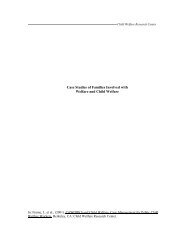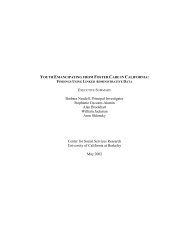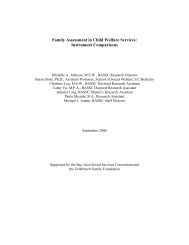Lack <strong>of</strong> prevention messages may decrease a patient’s awareness <strong>of</strong> certain riskfactors, health options, conditions, and screenings (Brown 2001). This lack <strong>of</strong> awarenessmay result in failure to screen or correctly diagnose a patient (Lavizzo-Mourey andMackenzie 1996; The Henry J. Kaiser Family Foundation 1999; Smedley et al. 2002).Moreover, insufficient knowledge about traditional remedies or practices may lead toserious medical complications. Drug interactions may occur between prescriptionmedications and folk medicines (Brach and Fraser 2000). A traditional remedy may becounterproductive or even dangerous, such as one for colic involving ingestion <strong>of</strong> amixture containing lead (Texas Department <strong>of</strong> Health 1998a). The practice <strong>of</strong> coinrubbingcould be mistaken for abuse 1 (Graham and Chitnarong 1997; Orr 1996).Miscommunication—including, but not limited to, verbal language barriers—can causeerrors in diagnosis and patient misunderstanding (Gany and Thiel de Bocanegra 1996;Perkins 1999; Putsch 1985; Queseda 1976; Villarruel et al. 1999).Underlying the argument for CLAS is the premise that linguistic and cultural barrierscan adversely affect the delivery <strong>of</strong> health care. There is some evidence that these barrierscan be reduced or eliminated through culturally sensitive interventions (Julia 1992;Lieberman 1990; Marin 1993; Moore 1992; Redmond 1990). Such health careinterventions require cultural and linguistic competence, which is “a set <strong>of</strong> congruentbehaviors, attitudes, and policies, that come together in a system, agency, or amongpr<strong>of</strong>essionals that enables effective work in cross-cultural situations” (Cross et al. 1989).Providers should be knowledgeable about the cultures <strong>of</strong> their clients—their customs,beliefs, and language (Clermont et al. 1993; Dillard et al. 1992; Fernandez-Santiago 1994;Krajewski-Jaime 1993; Pruegger and Rogers 1994; Redican 1994). For instance, inaddressing diabetes in African and Hispanic American communities, Raymond andD’Eramo-Melkus (1993) argue that effective treatment requires a sensitivity to andrecognition <strong>of</strong> such cultural patterns as food preferences, spiritual beliefs, and healthpractices in order to develop a practical and beneficial treatment regimen.In any interaction between consumers, patients, and their health care providers, theability <strong>of</strong> each party to understand and be understood by others is critical for appropriateand timely access and utilization <strong>of</strong> health care services, patient compliance, and positivepatient health outcomes. Also, in order for any system <strong>of</strong> health care to be truly effectivein serving populations whose national origins, languages, and cultural backgrounds differfrom those <strong>of</strong> employed or contracted staff <strong>of</strong> that health system, the organization shouldacknowledge and incorporate into practice the importance <strong>of</strong> valuing diversity and culture,and the adaptation <strong>of</strong> services that meet culturally unique needs (Association <strong>of</strong> AsianPacific Community Health Organizations AAPCHO 1996a). Such services involve effortsto enhance and ensure that health care providers and other personnel can both1 Coin rubbing consists <strong>of</strong> massaging the skin with tiger balm ointment and then rubbing the skin with ahot coin.COSMOS Corporation, December 2003 2-5
communicate with, and clearly understand, the concerns and needs <strong>of</strong> the consumers beingserved, as well as provide instructions, interventions, treatment modalities, and otherrecommended actions in a manner and context that will optimize consumer receptivity andcompliance.In sum, although issues <strong>of</strong> “cultural competence” or “cultural and linguisticappropriateness” in health care <strong>of</strong>ten are framed as “minority” issues, they are, in fact,human issues affecting all people. Everyone has a culture and a cultural background thatshapes one’s views about health and illness. Similarly, everyone has a language andlanguage needs. However, because some cultural and linguistic needs are met while othersare not, the issue becomes yet another <strong>of</strong> disparity in addressing the health needs <strong>of</strong> certaingroups—most <strong>of</strong>ten racial and ethnic minorities. This disparity directly affects the abilityto access and utilize high-quality health services.Given that: 1) disparities in health status and health care services are welldocumentedamong racial, ethnic, cultural, and linguistic minority groups; 2) cultural andlanguage differences may contribute to these gaps; and 3) the increasing racial, ethnic, andlinguistic diversity in the U.S., OMH set out to assist LPHAs by developing a CLAS selfassessmenttool for monitoring and improving health care quality.2.1.5 Defining CLASAt the project’s inception, the term “culturally appropriate” was seldom referenced inthe literature, while “cultural competence” was a more widely used term. Exhibit 2-1provides an overview <strong>of</strong> various definitions (in the literature at that time) for “culturallyappropriate health care services.” Most <strong>of</strong>ten, these services were described in terms <strong>of</strong> aset <strong>of</strong> skills related to understanding, and effectively communicating with, persons whohave diverse cultural backgrounds (McManus 1998; Tirado 1996). The term “culturalcompetence” was also described in the context <strong>of</strong> developing and using these skills(Andrulis 1997; California Department <strong>of</strong> Health Services 1993; Orlandi 1995). Otherdefinitions <strong>of</strong> cultural competence positioned the term in the health care context byemphasizing awareness and integration <strong>of</strong> three population-specific issues: health-relatedbeliefs and cultural values, disease incidence and prevalence, and treatment efficacy(Adams 1995; Lavizzo-Mourey and Mackenzie 1996).Linguistically appropriate services include programs, services, and interventions thatmeet the specific language needs <strong>of</strong> the service population (OMH 1996). Such servicesinvolve communicating with patients in their primary languages and providing languageassistance at key points <strong>of</strong> service throughout the health care continuum (AAPCHO1996b).COSMOS Corporation, December 2003 2-6
- Page 1 and 2: Developing a Self-Assessment Toolfo
- Page 3 and 4: ContentsChaptersPage1. Introduction
- Page 5 and 6: Chapter 1Introduction
- Page 7 and 8: While many LPHAs currently provide
- Page 9 and 10: LPHAs include: adult and child immu
- Page 11 and 12: Professions Education Partnership A
- Page 13 and 14: Chapter 2Methodology for Developing
- Page 15 and 16: Public Health Practice Program Offi
- Page 17: assess their own beliefs and have k
- Page 21 and 22: 2.1.6 Identifying Key Components of
- Page 23 and 24: Given these persistent disparities
- Page 25 and 26: (Exhibit 2-2, Continued)DOMAIN / KE
- Page 27 and 28: limited to the actual clinical enco
- Page 29 and 30: Chapter 3Project Results and Recomm
- Page 31 and 32: local board of health. PEP and PAG
- Page 33 and 34: numerous promising CLAS practices a
- Page 35 and 36: References
- Page 37 and 38: Becker, M.H., and L.A. Maiman, “S
- Page 39 and 40: Frye, B., “Health Care Decision M
- Page 41 and 42: Marin, G., “Defining Culturally A
- Page 43 and 44: Perkins, Jane, “Overcoming Langua
- Page 45 and 46: U.S. Bureau of the Census, “Censu
- Page 47 and 48: Appendix AMembership Lists of the P
- Page 49 and 50: Appendix A-1Developing a Self-Asses
- Page 51 and 52: Appendix A-2Developing a Self-Asses
- Page 53 and 54: Appendix B-1Overview of Eight CLAS
- Page 55 and 56: Domain 3: Culturally Inclusive Heal
- Page 57 and 58: understanding of diversity issues i
- Page 59 and 60: Appendix B-2Conceptual Framework fo
- Page 61 and 62: Appendix CLPHA Director or Designee
- Page 63 and 64: Pre-Interview Script for LPHA Direc
- Page 65 and 66: 3b. Which of the following are refl
- Page 67 and 68: 6. Does your agency have a formal p
- Page 69 and 70:
10. Which of the following describe
- Page 71 and 72:
Post-Interview Script for LPHA Dire
- Page 73 and 74:
Appendix DStaffing Questionnaire
- Page 75 and 76:
A. QUALITY MONITORING AND IMPROVEME
- Page 77 and 78:
B. MANAGEMENT INFORMATION SYSTEMS (
- Page 79 and 80:
7. Please indicate, if you know, th
- Page 81 and 82:
1c. Please indicate for which categ
- Page 83 and 84:
6. Please indicate for which catego
- Page 85 and 86:
10. Which of the following topical
- Page 87 and 88:
17. Which of the following benefits
- Page 89 and 90:
4. Which of the following strategie
- Page 91 and 92:
Appendix EClient Services Questionn
- Page 93 and 94:
A. QUALITY MONITORING AND IMPROVEME
- Page 95 and 96:
6b.Which of the following community
- Page 97 and 98:
3. Please report or estimate what p
- Page 99 and 100:
3. Which of the following practices
- Page 101 and 102:
Oral Interpretation Services10. Whi
- Page 103 and 104:
16. At which of the following key e
- Page 105 and 106:
3. Which of the following kinds of
- Page 107 and 108:
Appendix FPilot Test Response Form
- Page 109 and 110:
RESPONDENT EVALUATIONOF THE QUESTIO
- Page 111 and 112:
Appendix GCLAS in MCOs Study Data C
- Page 113 and 114:
position, as titles will likely var
- Page 115 and 116:
complex and uncertain at the time t
- Page 117 and 118:
1. Incorporate a confirmation pre-c
- Page 119 and 120:
Exhibit 2DATA COLLECTION PROCESSSen
















